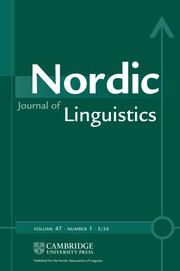This thematic issue of the Nordic Journal of Linguistics is dedicated to the emerging field of pragmatic borrowing. The term was introduced by Andersen (Reference Andersen2014) as an umbrella term for words and phrases borrowed from a source language (SL) into a recipient language (RL), that do not add to the propositional content of an utterance. Instead, the borrowed item functions as a discourse structuring device or indexes speakers’ attitude. Thus, pragmatic borrowing includes the incorporation of items that have been categorized as, for example, response particles, discourse markers, address terms, swearwords, interjections, and apologies. In addition to direct borrowing of single words and phrases such as yes and oh my god, speakers may also use indirect borrowing or calques, which are word-for-word translations of pragmatic items, and non-lexical features such as specific prosodic patterns and gestures (see Andersen Reference Andersen2014). In recent years, the term has become used in a broader sense referring to the ‘scientific meeting ground between contact linguistics and pragmatics’, also referring to the pragmatic issues regarding borrowing of lexical items that have a referential meaning (Andersen, Furiassi & Mišić Ilić Reference Andersen, Furiassi and Mišić Ilić2017:72).
Previous studies show that pragmatic items borrowed from English often adapt to the new language with respect to form and/or function (see Betz et al. Reference Betz, Deppermann, Mondada and Sorjonen2021 on okay), and that they can be used to index social and cultural values (Peterson Reference Peterson2017). In addition, the borrowed items have a different status and create different connotations in the borrowing language than in the source language (see Beers Fägersten Reference Beers Fägersten and Rathje2014 on the use of fuck in Swedish).
This thematic issue contributes to a base for understanding similarities and differences in how borrowing happens in a language community such as the Nordic region, with strong historical, cultural, and political ties throughout the Nordic corporation (see Peterson & Beers Fägersten Reference Peterson and Beers Fägersten2024). It comprises five articles on pragmatic borrowing from English. The studies selected for publication approach the theme by examining interactional data, predominantly with an interactionally informed methodology. The studies take on empirical data in several diverse languages: Danish, Icelandic, Finland-Swedish, Finnish, and Chilean Spanish, and use spoken everyday and media interactions (the first three articles) as well as written social media interactions (the two final articles) as their data.
Hilmisdóttir’s article ‘The interplay between a domestic and borrowed form: A comparison of ha and what in Icelandic conversation’ compares the use of the heritage form ha and the borrowed form what in spoken interaction. Both items can be approximated semantically to have the same meaning, but they fill different pragmatic functions in interaction. What is more limited in its use, whereas ha is more versatile both regarding function and where it is positioned in a turn. Thus, the article corroborates the claim that borrowed items do not necessarily outmanoeuvre domestic items, and they are often narrower, pragmatically and syntactically, than the equivalent heritage items.
In the second article, ‘Taking a stance with pragmatic borrowings: English response tokens in Finland-Swedish podcast conversations’, Huhtamäki, Peterson and Levälahti explore the prosody of borrowed response tokens. They show how borrowed pragmatic markers used as response tokens are prosodically marked for heightened involvement by the speakers. This is primarily done by means of wider pitch span than the surrounding talk. Similarly to Hilmisdóttir, the authors also show that the borrowed items perform a narrower, more specific function, in highlighting personal involvement by the speakers.
In his article ‘Fuck syntax and fucking syntax in the borrowing of swearwords for assessments in Danish’, Sørensen investigates how the linguistic items fuck and fucking are used in Danish conversation. Sørensen finds that while there is a Danish expletive, fanden, that has similar functions to fuck and is used in similar constructions, the heritage form is not replaced by the borrowed form, nor is the borrowed item restricted to the affordances supplied by fanden.
Koivisto and Lehtonen focus on the response particle jep in Finnish conversation. In their article ‘The contemporary uses of Finnish jep (“yep”) in messaging interaction: Confirming a shared understanding’, they argue that the particle is very seldom used as a straightforward affirmative answer to a question. Instead, it performs more interpersonally motivated functions, such as agreement or affiliation, confirming the validity of the previous speaker’s point of view.
In the last article, Rivera and Nurmikari contribute with a study of an acronym: ‘Wtf (“what the fuck”) as a pragmatic borrowing from English in Finnish and Chilean Spanish conversations on the social media platform X’. They compare the use in the source language American English with that in Finnish and Chilean Spanish. In all three languages, the acronym is used for expressing disbelief, astonishment, and problems accepting previous content. However, the use in the recipient languages Finnish and Chilean Spanish is narrower than that in the source language American English.
Lastly, we want to thank the NJL editors, especially Marit Julien, for making this thematic issue possible. We are very glad to be able to present a broad and rich view of a theme that is equally relevant and topical in all the Nordic and Scandinavian countries. We would also like to extend our thanks to the authors who have contributed to this issue. Without their enthusiasm and hard work, the issue would not have been possible. And, finally, we want to give credit and praise to the reviewers, who, with an eye for detail and scientific rigour, have taken time to make invaluable contributions to the publication process. We hope that the readers will enjoy this thematic issue and become inspired to contribute further to this young and expanding field!

